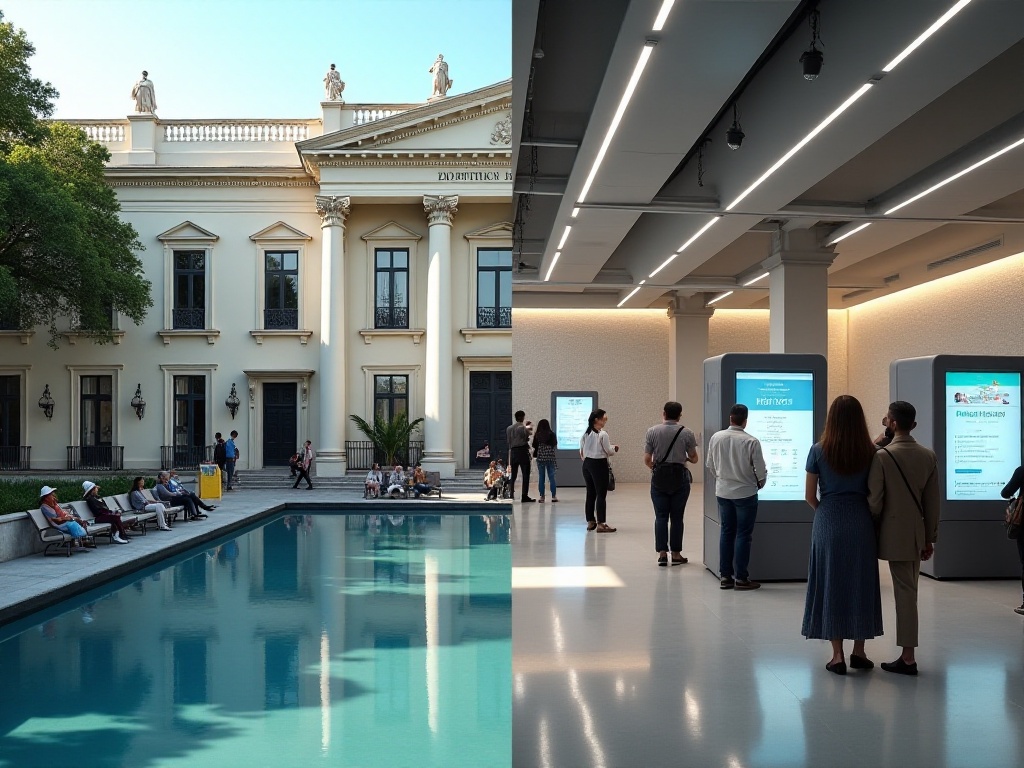Standing in front of this three-Michelin-starred restaurant in Tokyo's Ginza district, my heart began racing involuntarily. As a young food enthusiast with a unique passion for cuisine, dining at this 50-year-old prestigious kaiseki establishment felt like an extraordinary privilege. After waiting three full months for a reservation, I was finally about to experience kaiseki, renowned as the "pinnacle of Japanese cuisine."
The moment I pushed open the door, it felt like stepping into another world. The restaurant's decor was understated yet refined, with wooden furnishings emitting a subtle fragrance, ink paintings adorning the walls, and an indescribable air of elegance permeating the space.
To be honest, securing a reservation for authentic kaiseki is no easy feat. You need to book at least 2-3 months in advance, and many establishments only accept reservations through hotel concierges or specific channels. I succeeded in getting a reservation only because a friend working in Japan helped me.
My friend explained that such high-end kaiseki restaurants typically have strict reservation policies. Some even investigate potential diners' backgrounds, checking for previous Michelin restaurant experiences. However, there's no need to worry - most establishments welcome guests who show sufficient respect and enthusiasm for Japanese cuisine.
When making reservations, note that many restaurants only accept bookings in Japanese. Even in the internationally oriented Ginza area, few establishments offer English-language services. If you don't speak Japanese, it's best to seek help from a Japanese-speaking friend. Also, have a credit card ready, as many restaurants require deposits.
As I opened the door, a hostess in an elegant kimono immediately greeted me with a 90-degree bow. Her every movement exuded grace, naturally compelling one to maintain proper posture. At the entrance, I changed into the wooden clogs provided by the restaurant, part of Japanese traditional culture.
Walking through the tatami-lined corridor, the decorations were minimal yet exquisite. Calligraphy works hung on the walls, and seasonal flower arrangements adorned the corners. This corridor served as a transitional space, allowing one's mind to settle into tranquility.
Finally, I arrived at a roughly 100-square-foot private room. Though modest in size, it was perfectly appointed. Elegant cushions were placed on the tatami floor, a meticulously maintained Japanese garden was visible through the window, and an ancient lantern cast soft light throughout the space.

Kaiseki's primary focus is seasonality. Each dish strictly adheres to the principle of using seasonal ingredients, and even the choice of tableware changes with the seasons. In my dinner, for instance, there were five appetizers alone, each one a work of art.
The head chef personally visited our private room to introduce each dish. His expression while speaking was focused and proud, as if narrating a story about food. In his eyes, I saw boundless passion for cuisine.

The first course was pickled radish with umeboshi, accompanied by a small portion of fresh wasabi. The radish, specially pickled, was crisp with a subtle plum fragrance. The wasabi, air-shipped that morning from Shizuoka, was aromatic but not overwhelming. This appetizer immediately awakened the palate, building anticipation for the courses to follow.
Next came temari sushi made with pacific saury. The fish was purchased that dawn from Tsukiji Market, so fresh you could taste the ocean. The chef thinly sliced the fish, wrapped it with seasoned rice, and covered it with paper-thin nori. One bite combined the umami of the fish, the sweet-sour rice, and the fragrance of seaweed perfectly.
The third course was matsutake mushroom dobin-mushi. Matsutake, an autumn delicacy, is quite expensive. The chef sliced the mushroom and steamed it with ginkgo nuts and momiji fu in a special earthenware pot. When served, lifting the lid released an intense matsutake aroma. The clear broth contained profound umami flavors.
The most impressive dish was a seemingly simple clear soup. The chef used three types of fish - kinmedai, madai, and karei - simmered for eight full hours. The soup was crystal clear yet contained astonishing depth.
A delicate chrysanthemum-shaped radish floated in the soup, reportedly requiring 20 minutes of careful carving with special tools. A slice of yuzu added visual appeal and a subtle citrus fragrance to the broth.

The main course was simmered A5 Omi beef. The chef slow-cooked the beef in a special sauce, timing it perfectly. Each piece melted in the mouth almost without chewing, allowing every taste bud to experience the essence of the meat juices.
The sauce was made by simmering kombu, bonito flakes, sake, and other ingredients, creating a rich flavor that complemented rather than overshadowed the meat. The seasonal vegetable accompaniments were carefully cooked to maintain optimal texture.

The meal wasn't cheap, costing around 20,000 RMB per person. However, considering the details, the price is reasonable. First, every ingredient is top-tier. The wagyu beef alone costs thousands in the market. Matsutake mushrooms are extremely expensive, with a small piece costing over a thousand yuan.
Second is the value of craftsmanship. Each dish represents decades of the chef's expertise, from ingredient selection to cooking techniques to plating - everything is precisely calculated.
Add in the overall dining environment and service, and it becomes a feast of culinary artistry. Servers change tableware, refill water, and wipe tables at exactly the right moments. Every detail is perfected.
At this restaurant, I truly understood the meaning of "culinary art." Each dish demands excellence not only in taste, aroma, and appearance but also in plating aesthetics and seasonal expression.
Take the dessert, for example, which had a cherry blossom theme. The pink sakura mousse was silky smooth, melting instantly. It was decorated with real cherry blossom branches, deliberately spritzed with water droplets to evoke a spring garden. Even the dessert plate was custom-made with intricate cherry blossom patterns in the glaze.
Throughout the meal, I witnessed the Japanese pursuit of perfection in details. Even seemingly simple acts like pouring tea follow strict rules. Tea should fill seven-tenths of the cup, showing respect for guests while remaining practical to drink.

If you want to try kaiseki, I recommend starting with more affordable establishments. Tokyo has several one-Michelin-star kaiseki restaurants where you can experience the essence of this cuisine for 5,000-8,000 RMB per person.
When making reservations, it's best to have a Japanese-speaking friend help, as many restaurants only accept Japanese bookings. Also, consider lunch sets, which are usually much cheaper than dinner while maintaining similar quality.
Observe basic etiquette during the meal. Avoid using phones, as this may be seen as disrespecting the food. Try to express gratitude after each course. Even if there's a language barrier, a smile and nod can convey your appreciation.

Looking back, the experience remains vivid. From entering the restaurant to leaving, every detail reflected the Japanese dedication to and reverence for food.
Most memorable was the head chef's parting words: "I hope this meal conveyed our love for cuisine." Indeed, at this restaurant, I experienced not just food, but an unwavering pursuit of culinary excellence.
Whenever I recall this kaiseki experience in Tokyo, I'm amazed at how a meal can be so refined and elegant. Perhaps this explains why many people willingly wait months for this experience despite the high cost.
This was more than just a meal - it was a deep exploration of food, art, and culture. It gave me a new perspective on Japanese cuisine and helped me understand why kaiseki is called the "pinnacle of Japanese cuisine."
If you have the chance to visit Tokyo, I highly recommend trying this experience. Though expensive, it will become an unforgettable culinary memory. Here, you can taste not just exceptional food but also experience a country's culinary culture and aesthetic pursuits.
This is perhaps the allure of kaiseki. It's not just a meal, but a ceremony, a condensation of centuries-old food culture. In our fast-paced era, taking time to savor such a meal is itself a luxury.
 Previous
Previous
